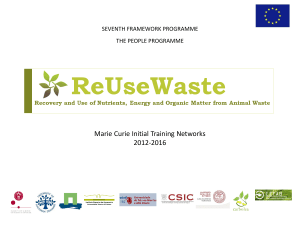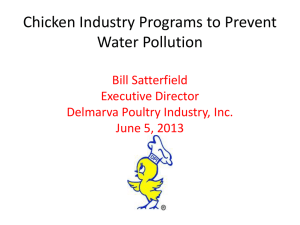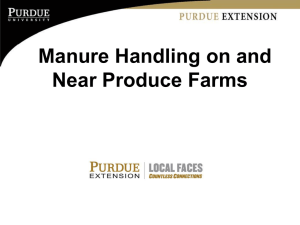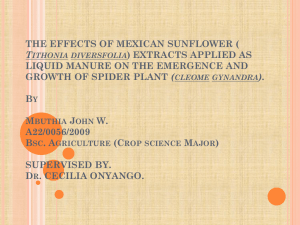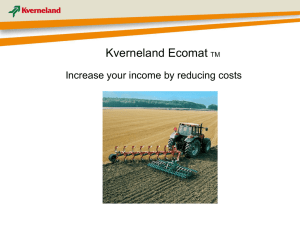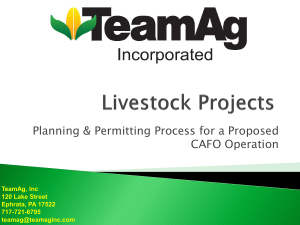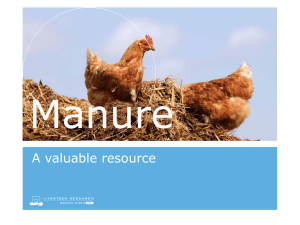PA`s Revised Manure Management Manual Presentation
advertisement
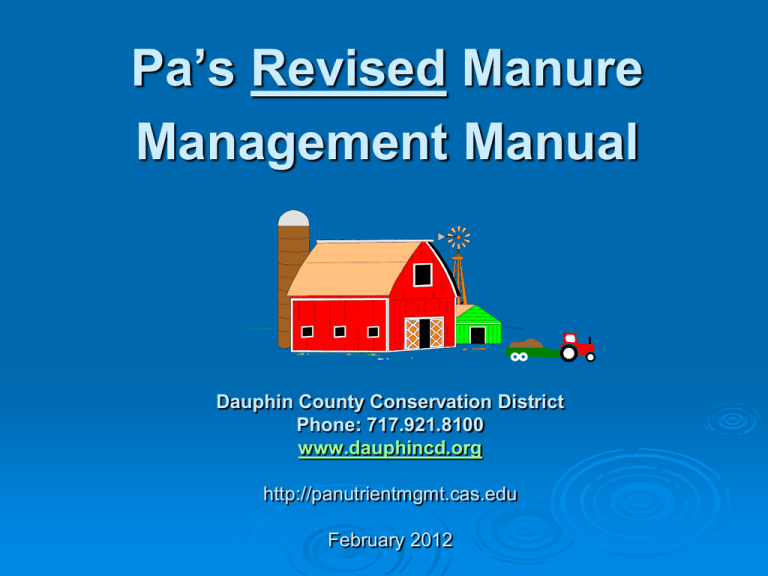
Pa’s Revised Manure Management Manual Dauphin County Conservation District Phone: 717.921.8100 www.dauphincd.org http://panutrientmgmt.cas.edu February 2012 Proper Manure Management, it’s a good idea Get the maximum use of your on-farm resources Manure has: Organic matter (water holding, nutrient holding, soil microbes) Micro/Secondary nutrients (Calcium, Magnesium, Sulfur, Zinc, etc) Macro nutrients (N – P – K) The value of manure based on N-P-K value alone is: ($287/cow/yr); ($785/1000 broilers); ($34/hog/yr) Proper management is also required by law All farms that use manure have state requirements, requirements vary based on farm scope In the past, the emphasis was on larger operations, new emphasis will be on smaller operations 2 Animal Operations in PA All Animal Operations (AOs) All operations generating/utilizing manure * Regulated by PA DEP AOs (40,000+) Concentrated Animal Operations (CAOs) High animal density farms farms > 2,000 lbs/acre animal density * Regulated by PA SCC • Approved nutrient mgmt plan Approvedplanner nutrient mgmt plan • Certified • Public CAFO permit accessfrom DEP • Certified planner • Public access CAOs (1,050+) CAFOs (365+) Concentrated Animal Feeding Operations (CAFOs) Based on animal numbers and/or animal density Farms > 1,000 AEUs, CAOs > 300 AEUs, EPA head #’s * Regulated by PA DEP (for US EPA) 3 AOs Manure management on smaller farms All farms generating/using manure must have a manure mgmt plan (or Nutrient Mgmt Plan, CNMP plan) Includes very small (one horse) operations and operations without any animals as long as manure is spread there Must be a written plan (including farm map), kept on site • No submission and no approval required Can be written by farmer or other non-certified individual New DEP approved standardized planning includes: • N and P application rates, • Application setbacks, winter application • Pastures , Barnyard runoff • Storage and stacking criteria 4 Manure Application Rates 3 options for developing manure rates: 1) Use manure application charts (easy, but not farm specific) N based if current soil test < 200 ppm P P based if > 200 ppm P or no soil test (approx 1/3 N rate) No certified planner required Based on crop and manure type 2) Use Nutrient Balance Sheet worksheet (harder but site specific) N based if < 200 ppm P; P based if > 200 ppm P or no soil test No certified specialist required 3) Use the PA Phosphorus-Index (most complex but most flexible) Will need to use an authorized planner N or P based dependent on the results of the P-index May allow for N based application on soils with > 200 ppm P Application Rate, Charts Finding rate for spring applied liquid dairy manure on 23 ton corn silage Nitrogen Based Liquid Dairy Manure Application Setbacks Year-round manure application setbacks Only relevant to mechanical manure application • No setbacks for pastures 100’ manure application setbacks established for • Streams; (at times when water flows in these channels) • Lakes, ponds, existing open sinkholes • Private or public drinking water source Setback may be reduced for streams, lakes, ponds: • 100’ if not using no-till and cover crops and no buffer • 50’ if < 200 ppm P, using no-till and cover crop, but no buffer • 35’ setback if using a permanent veg buffer next to stream Winter Spreading Restrictions “Winter” is anytime any one of the following are true: The date is on or between Dec. 15 to Feb. 28, or The ground is frozen 4 inches or more, or The ground is snow covered A maximum application rate for the winter months : 5,000 gallons per acre of liquid manure 20 tons per acre dry non-poultry manure 3 tons per acre dry poultry manure 25% plant or residue cover at application time No winter application on slopes steeper than 15% A, B and C slopes acceptable Pasture Management Pastures on the farm must be included in plan Pastures are a crop field that must be nutrient balanced. Pastures need to be properly managed by either: Maintaining dense vegetation including always having at least 3” growth during growing season, or Implementing a grazing plan meeting the NRCS standard Stream bank fencing restricting animal access to a stream is not required for a true pasture If overgrazed, then the field would be considered a barnyard (ACA) requiring addition protections including animal exclusion from the stream Animal Concentration Area Management (ACAs) ACAs must be included in the plan These are barnyards, exercise lots, other denuded animal concentration areas ACA criteria include: Diverting upslope water Ensuring polluted runoff goes into storage or vegetative treatment strip or system Remove manure where it accumulates Disallowing animal access to streams except properly constructed crossings Keeping watering areas, feed areas, etc away from streams when possible Manure Storage Requirements As of 2000, all newly built liquid and semi-solid manure storages must be: Manure storage facilities requiring a DEP permit: Designed by a Pa registered Professional Engineer Construction must be signed off by engineer and certification kept on site > 2.5 million gallons > 1.0 million gallons in a SP or impaired watershed Maintaining your manure storage: Check for leaks, overflow, trees, or other problems Must maintain required freeboard In-Field Manure Stacking In-field stacking of manure on unimproved areas is allowed if following the below restrictions Criteria to address unimproved in-field stacking areas: 100’ setback from streams, water wells and sinkholes Diverting upslope water where necessary Placing the stack on less than 8% slopes Not same place as last year Having a dry enough manure to allow it to be stacked Covering the stack if it will be there more than 120 days Stacking on improved areas (such as in the farmstead) does not need to follow these same restrictions, just no direct runoff to waters AOs CAOs CAFOs In conclusion… All animal farms Manure Management Plan (pre-approved standardized format) Can be written by farmer Addresses manure application as well as ACAs, pastures and barnyards No submission , review or approval Higher density animal farms (CAOs) Nutrient Management Plan, more detailed plan format Must be written by certified planner Plan must be submitted, reviewed and approved by cons district Larger animal farms (CAFOs) Nutrient Management Plan, like for CAOs (submission and approval) DEP CAFO Permit 13 In Conclusion… Begin now to develop your plan Determine if you need a manure mgmt plan or a nutrient management plan • Are you a CAO or CAFO Get a copy of the MMM workbook and instructions Take soil tests Get a farm map (from FSA, District, OneStop, etc) Determine average crop yields Identify nearby wells, streams, sinkholes Calibrate your manure spreader (AF 68) 14 In Conclusion…(“begin now” continued) Determine if winter application is necessary • If so, look for fields (slope and setbacks) Check manure storage for problems • Leaking, trees or shrubs, cracks or tears. Check for ACA runoff to nearby streams, etc Look for good manure stacking areas if needed Check pasture for dense vegetation Keep manure application/storage records Get help with your planning if needed • Cons. district, PSU ext, Ag orgs, private planners, etc • Workshops may be planned for your area soon 15 Website to print copies of the new Manure Mgmt Manual http://panutrientmgmt.cas.psu.edu • Button on left “Manure Management Manual Program” 16


